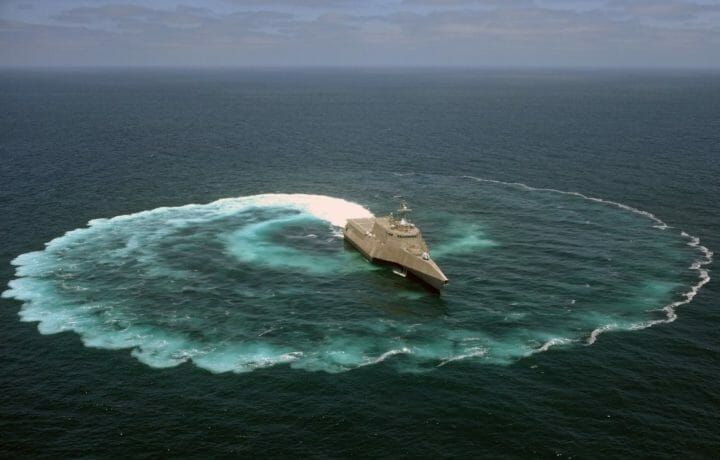Last month, the United States Navy decommissioned the USS Independence (LCS-2) with little fanfare in a pier-side ceremony in San Diego. The namesake of the Navy’s Independence-class of Littoral Combat Ship (LCS) left the fleet after just 11 years in service, far shorter than the expected 25 year lifespan the Navy had envisioned for the fast-moving warships that were designed to operate close to shores.
The LCS program began when the U.S. military was engaged in the Global War on Terror (GWOT) following the September 11, 2001 attacks. The LCS was seen as ideal for combating missile-firing boats, and even small submarines, while it was envisioned that the stealthy surface combatants could be capable of defeating anti-access and asymmetric threats in littoral or near-shore waters.
What was unique about the LCS was that the Navy opted for two unique classes of vessels – each slightly smaller than the Oliver Hazard Perry-class frigate. The first was the Freedom-class, which was designed by Lockheed Martin and built by Marinette Marine in Marinette, Wisconsin. It was the smaller of the two; a steel-hulled 387-foot warship that utilized a semi-planing monohull. The second variant was the Independence-class, featuring a trimaran with a slender stabilized mono-hull that could allow flight operations for its helicopters in up to sea state five (rough) conditions. The 421-foot all-aluminum warship was designed and built by Austral USA in Mobile, AL.
First to be Decommissioned
The decommissioning of the USS Independence had been announced earlier this year, even as the Navy has continued to commission newer LCSs. In the case of LCS-2, the 3000-ton warship had been used as a testbed for mission package and development.
It will soon be joined by the USS Freedom (LCS-1), which will be decommissioned next month.
In its Fiscal Year 2021 (FY21) budget, the Navy said the warships were too expensive to upgrade to address the new era of “great power competition,” and instead requested they be axed. According to a Chief of Naval Operations (CNO) Adm. Mike Gilday said earlier this year that it would take $2.5 billion to upgrade the first four ships of the program, and that money could instead be put toward the emerging Constellation-class frigate (FFG-62) program.
In the Navy’s current FY22 budget submission, the service asked to cut four additional LCS including USS Coronado (LCS-4), USS Fort Worth (LCS-3) USS Detroit (LCS-7) and USS Little Rock (LCS-9). The Navy commissioned Forth Worth in 2012 and Coronado in 2014, while Detroit was commissioned in 2016, and Little Rock in 2017.
Two Classes With One Problem
As noted, the LCS was developed when the U.S. was engaged in the GWOT, and the vessels were meant to emphasize speed, and could utilize flexible mission modules, while operating where larger warships could not. However, the ships have been prone to breakdowns.
After Congress cut the funding for the mission modules, the Navy was left with small and fast ships that have earned the moniker “Little Crappy Ships” by some sailors. Today, critics of the program argue the LCS doesn’t fit with the Navy’s long-term fleet goals that consist of aircraft carriers, destroyers, and other surface combatants.
A new class of frigates, along with unmanned ships and aircraft, could do the jobs the Navy envisioned for the LCS, and do it more cost-effectively, critics maintain.
A Government Accountability Office (GAO) report from April, found that the Navy still has planned to spend $61 billion to maintain and operate its LCS fleet. The earliest produced ones are now entering the Navy’s maintenance cycle, which has higher than expected costs.
Some lawmakers haven’t agreed with the Navy’s assessment to cut its losses while moving to a new class of warship.
“I’m not buying it,” Rep Elaine Luria (D-Virginia) had told USNI News in May. “We need to look at what we have today and how we can use it and how we can use it most efficiently. The idea of divesting of current platforms that still have usable service life in order to invest in something that we might develop the technology for in the future – paired with our poor track record on [developing new] platforms – just makes absolutely no sense to me.”
The Navy may have to adapt to how it utilizes the class of warships, and in some cases the LCS could do the job better than other vessels especially in the littoral waters for which it was designed. In April, USS Freedom was deployed in joint anti-drug operations with the U.S. Coast Guard. While operating in the U.S. Third Fleet waters, LCS-1 and embarked Helicopter Sea Squadron 23 identified and approached an illicit drug transport boat, and assisted the Coast Guard, which conducted a boarding, search, and seizure. More than 1,500 kilograms of cocaine was seized during the operation.




